《药理学》课程PPT教学课件(Endocrine Sys)35 insullin
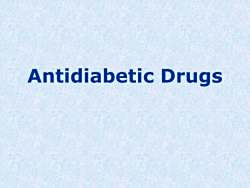
Antidiabetic Drugs
Antidiabetic Drugs
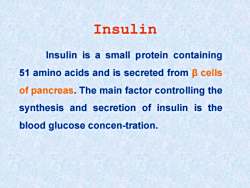
InsulinInsulin is a small protein containing51 amino acids and is secreted from β cellsof pancreas.The main factor controlling thesynthesis and secretion of insulin is theblood glucose concen-tration
Insulin Insulin is a small protein containing 51 amino acids and is secreted from β cells of pancreas. The main factor controlling the synthesis and secretion of insulin is the blood glucose concen-tration
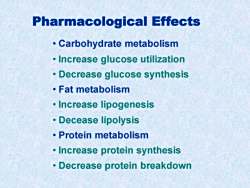
Pharmacological Effects.Carbohydrate metabolism·Increase glucose utilization·Decrease glucose synthesisFatmetabolismIncreaselipogenesis·Decease lipolysisProteinmetabolismIncreaseproteinsynthesis·Decrease protein breakdown
Pharmacological Effects • Carbohydrate metabolism • Increase glucose utilization • Decrease glucose synthesis • Fat metabolism • Increase lipogenesis • Decease lipolysis • Protein metabolism • Increase protein synthesis • Decrease protein breakdown
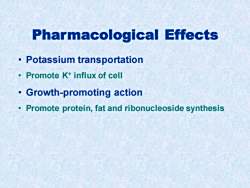
PharmacologicalEffects.Potassiumtransportation.PromoteKtinfluxofcell·Growth-promotingactionPromote protein,fatand ribonucleoside synthesis
Pharmacological Effects • Potassium transportation • Promote K+ influx of cell • Growth-promoting action • Promote protein, fat and ribonucleoside synthesis
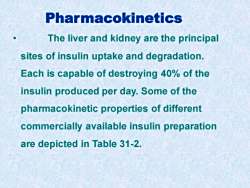
PharmacokineticsThe liver and kidney are the principalsites of insulin uptake and degradationEach is capable of destroying 40% of theinsulin produced per day.Some of thepharmacokinetic properties of differentcommercially available insulin preparationaredepicted inTable31-2
Pharmacokinetics • The liver and kidney are the principal sites of insulin uptake and degradation. Each is capable of destroying 40% of the insulin produced per day. Some of the pharmacokinetic properties of different commercially available insulin preparation are depicted in Table 31-2
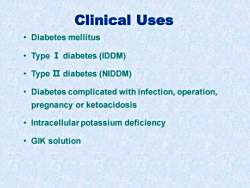
Clinical UsesDiabetesmellitusTypeI diabetes(IDDM)Type diabetes(NIDDM)·Diabetes complicated withinfection,operationpregnancy or ketoacidosisIntracellularpotassiumdeficiency.GlKsolution
Clinical Uses • Diabetes mellitus • Type Ⅰ diabetes (IDDM) • Type Ⅱ diabetes (NIDDM) • Diabetes complicated with infection, operation, pregnancy or ketoacidosis • Intracellular potassium deficiency • GIK solution

Untoward Effects·HypoglycemiaResponsivehyperglycemiaAllergicreactionInsulinresistanceLocalreactions
Untoward Effects • Hypoglycemia • Responsive hyperglycemia • Allergic reaction • Insulin resistance • Local reactions
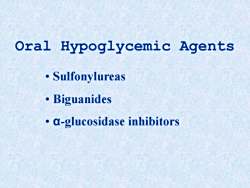
Oral Hypoglycemic Agents.Sulfonylureas·Biguanides·α-glucosidase inhibitors
Oral Hypoglycemic Agents • Sulfonylureas • Biguanides • α-glucosidase inhibitors
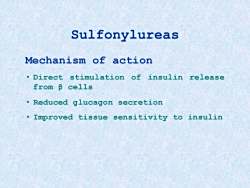
SulfonylureasMechanism of action.Directstimulationofinsulinreleasefrom β cellsReduced glucagonsecretionImproved tissuesensitivity to insulin
Sulfonylureas Mechanism of action • Direct stimulation of insulin release from β cells • Reduced glucagon secretion • Improved tissue sensitivity to insulin
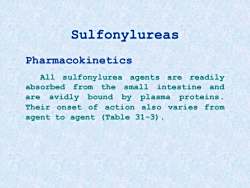
SulfonylureasPharmacokineticsAll sulfonylurea agents are readilyabsorbedfromthesmallandintestine福areavidly bound by plasmaproteinsTheironsetofactionalsovariesfromagent to agent(Table 3l-3)
Sulfonylureas Pharmacokinetics All sulfonylurea agents are readily absorbed from the small intestine and are avidly bound by plasma proteins. Their onset of action also varies from agent to agent (Table 31-3)
按次数下载不扣除下载券;
注册用户24小时内重复下载只扣除一次;
顺序:VIP每日次数-->可用次数-->下载券;
- 《药理学》课程PPT教学课件(Cardiovascular Sys)25 treatment for arrthymia2.ppt
- 《药理学》课程PPT教学课件(Cardiovascular Sys)23 diuretic.ppt
- 《药理学》课程PPT教学课件(Cardiovascular Sys)20 anti-inflammation drugs.ppt
- 《药理学》课程PPT教学课件(Cardiovascular Sys)29 treatment for angina pectoris.ppt
- 《药理学》课程PPT教学课件(Cardiovascular Sys)27 treatment for CHF2.ppt
- 《药理学》课程PPT教学课件(Cardiovascular Sys)28 Agents Used in Hyperlipidemia.ppt
- 《药理学》课程PPT教学课件(Central Nervous Sys)12 central nervous system stimulants.ppt
- 《药理学》课程PPT教学课件(Central Nervous Sys)17 Antiparkin.ppt
- 《药理学》课程PPT教学课件(Central Nervous Sys)13 anesthesia.ppt
- 《药理学》课程PPT教学课件(Central Nervous Sys)18 neuroleptic drugs.ppt
- 《药理学》课程PPT教学课件(Central Nervous Sys)19 opioid analgesics and antagonists.ppt
- 《药理学》课程PPT教学课件(Efferent Sys)05 the autonomic nervous system.ppt
- 《药理学》课程PPT教学课件(Efferent Sys)10 adrenergic agonists.ppt
- 《药理学》课程PPT教学课件(Efferent Sys)06 cholinergic agonists.ppt
- 《药理学》课程PPT教学课件(Efferent Sys)07 adrenergic antagonists.ppt
- 《药理学》课程PPT教学课件(Efferent Sys)12 antidepression.ppt
- 《药理学》课程PPT教学课件(抗菌药物)第三十八章 抗菌药物概论.ppt
- 《药理学》课程PPT教学课件(抗菌药物)第三十九章 β-内酰胺类抗生素.ppt
- 《药理学》课程PPT教学课件(抗菌药物)第四十一章 氨基苷类抗生素.ppt
- 《药理学》课程PPT教学课件(抗菌药物)第四十章 大环内酯类.ppt
- 《药理学》课程PPT教学课件(Endocrine Sys)34 adrenocortical hormones.ppt
- 《药理学》课程PPT教学课件(Endocrine Sys)36 thyroid drugs.ppt
- 《药理学》课程PPT教学课件(Antimicrobial Drugs)43b Sulfonamides and other Synthetic Antimicrobial Drugs.ppt
- 《药理学》课程PPT教学课件(Antimicrobial Drugs)43a Quinolones and Urinary Tract Antiseptics.ppt
- 《药理学》课程PPT教学课件(Antimicrobial Drugs)41 Aminoglycosides.ppt
- 《药理学》课程PPT教学课件(Antimicrobial Drugs)42 Tetracyclines, Chloramphenicol.ppt
- 《药理学》课程PPT教学课件(Antimicrobial Drugs)38 Principles of Antimicrobial Therapy.ppt
- 《药理学》课程PPT教学课件(Antimicrobial Drugs)40 Macrolides, Lincomycin, Clindamycin.ppt
- 《药理学》课程PPT教学课件(Antimicrobial Drugs)39 Inhibitors of Cell Wall Synthesis.ppt
- 《生物药剂学与药物动力学》课程教学大纲 Biopharmaceutics and Pharmacokinetics.doc
- 《生物药剂学与药物动力学》课程教学资源(教案,2012版).doc
- 《生物药剂学与药物动力学》课程教学资源(讲稿,2014版).doc
- 《生物药剂学与药物动力学》课程教学资源(试卷习题)试卷6(答案).doc
- 《生物药剂学与药物动力学》课程教学资源(试卷习题)试卷5(答案).doc
- 《生物药剂学与药物动力学》课程教学资源(试卷习题)试卷6(试题).doc
- 《生物药剂学与药物动力学》课程教学资源(试卷习题)试卷5(试题).doc
- 《生物药剂学与药物动力学》课程教学资源(试卷习题)试卷3(答案).doc
- 《生物药剂学与药物动力学》课程教学资源(试卷习题)试卷4(答案).doc
- 《生物药剂学与药物动力学》课程教学资源(试卷习题)试卷4(试题).doc
- 《生物药剂学与药物动力学》课程教学资源(试卷习题)试卷3(试题).doc
